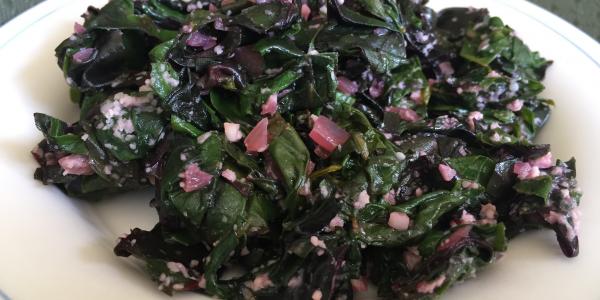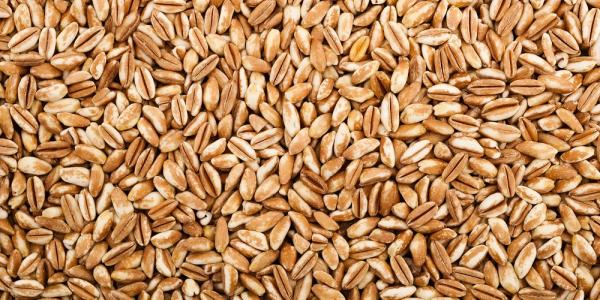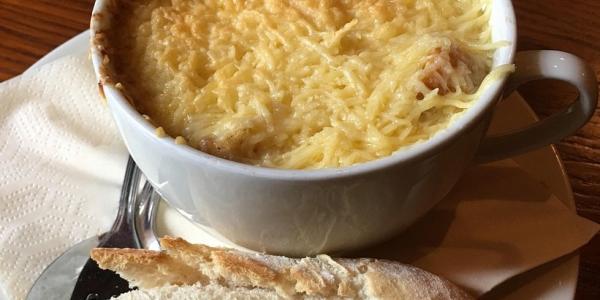Sauteed Swiss Chard

Ingredients
- 1 bunch (about 1 lb.) Swiss chard
- 2 T. extra virgin olive oil
- 1 T. minced garlic
- ¼ c. julienne shallot
- 1 T. unsalted butter
- ½ c. white wine
- ½ to 1 T. fresh lemon juice
- Salt and pepper to taste
- 2 T. freshly grated Parmesan cheese
Preparation
Remove stems and center ribs from chard; discard tough portions, then cut stems and ribs crosswise into 2-inch pieces. Stack chard leaves and roll up lengthwise into cylinders. Cut cylinders crosswise to make 1-inch-wide strips. Set aside both parts keeping them separate.
Heat olive oil in a large skillet over medium-high heat. Stir in the garlic and shallot; cook for 30 seconds until fragrant.
Add the chard stems and deglaze the pan with the white wine. Simmer until the stems begin to soften, about 3-5 minutes. Stir in the chard leaves, and cook until wilted. Toss with lemon juice, salt and pepper to taste.
Use a slotted spoon to transfer chard to serving bowl. Top with Parmesan cheese.
Learn More About Swiss Chard
Inexplicably, chard is called Swiss chard in the U.S. Since chard is native to the Mediterranean region, not Switzerland, I asked around, “Why is chard called Swiss chard?” Two main themes emerged—because its leaves have holes like Swiss cheese (they sometimes do); and to add a touch of elegance to a name that, in the English language, reminds one of burnt food (charred).
Happily, chard tastes nothing like it sounds. Raw chard is pleasantly tart, turning sweet and meltingly tender when cooked.
Chard derives from the beet family and is a two-for-one vegetable:
1. The ribs and stems are white, red, yellow or orange; bunches of “Rainbow chard” have some of each. Ribs wider than an inch require longer cooking time than the leaves.
2. Chard’s dark green leaves are curly-edged and should feel crisp, not limp. Leaf size is not an indicator of age, flavor or texture. Like other greens, Swiss chard has a high water content causing it to shrink drastically when cooked. It takes about a pound of leaves, cleaned and cooked, to serve 3 or 4 chard lovers.
Store unwashed chard in a plastic bag in the refrigerator for up to five days. When you’re ready to use it, separate the leaves from the stems. To do this, fold each chard leaf in half and place on a cutting board; cut along the rib through both thicknesses of the leaf. Another method is to grasp the folded leaf with one hand and pull the rib away with the other hand as if separating perforated paper. Next swish the leaves in a generous container of water, shake off excess water and coarsely chop. The stems need to be washed as well, then chopped.
The leaves can be served raw or cooked simply by steaming, boiling or sautéing; added to soups or stuffed. The crisp-textured stems and ribs need separate preparation but may be added with the leaves in a single dish.
Peggy Crum MA, RDFeatured Recipes

Rhubarb & Strawberry Crisp
Combine tart rhubarb with sweet strawberries, add a streusel topping, and bake until bubbly. Dessert doesn’t get easier—or more classic—than this. Serve warm with a scoop of vanilla ice cream. You’re sure to get rave reviews!

Farro Salad with Grilled Vegetables
Chewy farro grains are delicious in this autumn-y salad. Recipe yields enough for dinner for 2 to 4 with some left for a couple of lunches. To do this, make the base with dressing, farro, and grilled veggies. Add fresh veggies to the base as you go.

Pecan and Dark Chocolate Chip Cookies
Roasting amps up the flavor in everything including pecans. Chef Kurt's attention to detail takes a traditional chocolate chip cookie to another level of yum!

Onion Soup
Onions, the simplest of pantry staples, mingle with butter, broth, and herbs to become luxuriously smooth and delicious. Add "homemade" croutons and a blend of cheeses to make a complete and satisfying meal.





